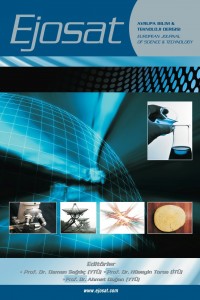Tekstürlü kesici takımların Ti6Al4V alaşımının ortogonal kesilmesindeki etkinliğinin araştırılması: nümerik bir yaklaşım
Abstract
Bu araştırma, mikro
textürlü kesici takımların Ti6Al4V alaşımının kuru ortogonal kesilmesindeki
etkinliğini, 2D nümerik analiz yöntemi kullanarak incelemektedir. Bu maksatla,
farklı boyutlardaki mikro kanalları, kesici takımların talaş yüzeyi üzerinde
oluşturulmuştur. Bunun üzerine ortogonal kesme simülasyonları, farklı talaş
açısına sahip takımlar kullanılarak gerçekleştirilmiştir. Takım-talaş ara yüzündeki
temas mesafesi, kesme kuvvetleri ve kuvvet oranı sonuçları, mikro kanalların
performansına odaklanılarak değerlendirildi. Amaç, tekstürlü kesici takımların
geliştirilmesindeki bilgi birikimine katkı sağlayarak, proses veriminin
arttırılması ve negatif çevresel etkilerin minimize edilmesidir. Simülasyon
sonuçları, tekstürlü kesici takımların kullanımı ile daha düşük kesme
kuvvetleri, kuvvet oranı ve temas mesafesi elde etmenin mümkün olduğunu
göstermiştir. Ancak, tekstür parametrelerinin hatalı seçimi, artan sürtünme
gibi, ters etkilere de neden olabilmektedir. Buradan hareketle, mikro
kanalların etkinliğinin hem kanal boyutuna hem de talaş açısına bağlı olduğu
söylenebilir.
References
- Su, Y., et al., Cutting performance of micro-textured polycrystalline diamond tool in dry cutting. Journal of Manufacturing Processes, 2017. 27: p. 1-7.
- Arulkirubakaran, D., V. Senthilkumar, and V. Kumawat, Effect of micro-textured tools on machining of Ti–6Al–4V alloy: an experimental and numerical approach. International Journal of Refractory Metals and Hard Materials, 2016. 54: p. 165-177.
- Obikawa, T., et al., Micro-texture at the coated tool face for high performance cutting. International Journal of Machine Tools and Manufacture, 2011. 51(12): p. 966-972.
- Xing, Y., et al., Cutting performance and wear mechanism of nanoscale and microscale textured Al2O3/TiC ceramic tools in dry cutting of hardened steel. International Journal of Refractory Metals and Hard Materials, 2014. 43: p. 46-58.
- Ma, J., et al., FEM assessment of performance of microhole textured cutting tool in dry machining of Ti-6Al-4V. The International Journal of Advanced Manufacturing Technology, 2016. 84(9-12): p. 2609-2621.
- Deform-2D, Version 11 User Manual. STFC, Columbus, Ohio State, USA, 2014.
- Johnson, G.R. and W.H. Cook, Fracture characteristics of three metals subjected to various strains, strain rates, temperatures and pressures. Engineering fracture mechanics, 1985. 21(1): p. 31-48.
- Lee, W.-S. and C.-F. Lin, High-temperature deformation behaviour of Ti6Al4V alloy evaluated by high strain-rate compression tests. Journal of Materials Processing Technology, 1998. 75(1-3): p. 127-136.
- Kawasegi, N., et al., Development of cutting tools with microscale and nanoscale textures to improve frictional behavior. Precision Engineering, 2009. 33(3): p. 248-254.
- Özel, T., et al., Investigations on the effects of multi-layered coated inserts in machining Ti–6Al–4V alloy with experiments and finite element simulations. CIRP Annals, 2010. 59(1): p. 77-82.
- Choudhury, S.K. and K.K. Kishore, Tool wear measurement in turning using force ratio. International Journal of Machine Tools and Manufacture, 2000. 40(6): p. 899-909.
- Devillez, A., et al., Cutting forces and wear in dry machining of Inconel 718 with coated carbide tools. Wear, 2007. 262(7): p. 931-942.
- Shaw, M.C. and J. Cookson, Metal cutting principles. 1984: Clarendon press Oxford.
Efficiency investigations of textured cutting tools in orthogonal cutting of Ti6Al4V alloy: a numerical approach
Abstract
This paper investigates efficiency of micro-textured cutting tools in
dry orthogonal turning of Ti6Al4V alloy using 2D numerical analysis. For this
purpose, micro-grooves at different sizes were generated on rake face of
cutting tools. Then, orthogonal cutting simulations were conducted using
different tool rake angle values. Contact length at tool-chip interface,
cutting force and force ratio results were evaluated focusing on performance of
micro grooves. The aim was to improve process efficiency and minimize negative
environmental impacts by contributing knowledge in development of textured
cutting tools. The simulation results revealed that decreased forces, force
ratio and contact length is possible with use of textured cutting tools.
However, improper selection of texture parameters may cause adverse effects
such as increased friction. Accordingly, efficiency of micro-grooves relies on
both, groove size and rake angle.
References
- Su, Y., et al., Cutting performance of micro-textured polycrystalline diamond tool in dry cutting. Journal of Manufacturing Processes, 2017. 27: p. 1-7.
- Arulkirubakaran, D., V. Senthilkumar, and V. Kumawat, Effect of micro-textured tools on machining of Ti–6Al–4V alloy: an experimental and numerical approach. International Journal of Refractory Metals and Hard Materials, 2016. 54: p. 165-177.
- Obikawa, T., et al., Micro-texture at the coated tool face for high performance cutting. International Journal of Machine Tools and Manufacture, 2011. 51(12): p. 966-972.
- Xing, Y., et al., Cutting performance and wear mechanism of nanoscale and microscale textured Al2O3/TiC ceramic tools in dry cutting of hardened steel. International Journal of Refractory Metals and Hard Materials, 2014. 43: p. 46-58.
- Ma, J., et al., FEM assessment of performance of microhole textured cutting tool in dry machining of Ti-6Al-4V. The International Journal of Advanced Manufacturing Technology, 2016. 84(9-12): p. 2609-2621.
- Deform-2D, Version 11 User Manual. STFC, Columbus, Ohio State, USA, 2014.
- Johnson, G.R. and W.H. Cook, Fracture characteristics of three metals subjected to various strains, strain rates, temperatures and pressures. Engineering fracture mechanics, 1985. 21(1): p. 31-48.
- Lee, W.-S. and C.-F. Lin, High-temperature deformation behaviour of Ti6Al4V alloy evaluated by high strain-rate compression tests. Journal of Materials Processing Technology, 1998. 75(1-3): p. 127-136.
- Kawasegi, N., et al., Development of cutting tools with microscale and nanoscale textures to improve frictional behavior. Precision Engineering, 2009. 33(3): p. 248-254.
- Özel, T., et al., Investigations on the effects of multi-layered coated inserts in machining Ti–6Al–4V alloy with experiments and finite element simulations. CIRP Annals, 2010. 59(1): p. 77-82.
- Choudhury, S.K. and K.K. Kishore, Tool wear measurement in turning using force ratio. International Journal of Machine Tools and Manufacture, 2000. 40(6): p. 899-909.
- Devillez, A., et al., Cutting forces and wear in dry machining of Inconel 718 with coated carbide tools. Wear, 2007. 262(7): p. 931-942.
- Shaw, M.C. and J. Cookson, Metal cutting principles. 1984: Clarendon press Oxford.
Details
| Primary Language | English |
|---|---|
| Subjects | Engineering |
| Journal Section | Articles |
| Authors | |
| Publication Date | December 31, 2018 |
| Published in Issue | Year 2018 Issue: 14 |

